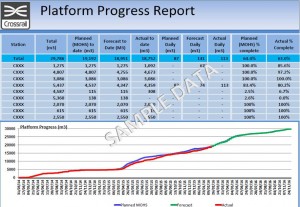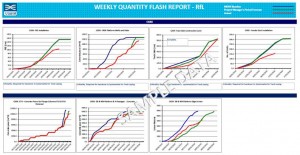
Key Commodity Monitoring
Document
type: Micro-report
Author:
Nilesh Patel BSc
Publication
Date: 26/02/2016
-
Abstract
Crossrail defines a commodity as a measurable piece of work (eg, linear metres of tunnelling, track laying, platform concrete poured etc). It was recognised that the early identification and monitoring of key commodities was critical to programme success and effective decision making.
Undertaking Commodity reporting enabled Crossrail to gain a better understanding of the time frames and resource requirements to complete specific work packages. This also enabled project teams to make informed decisions for managing critical tasks and prioritising work to meet key dates. Utilising this approach allowed Crossrail to effectively manage the Programme across several large projects that required collaborate working practices.
-
Read the full document
Introduction
The Crossrail programme delivery team required a mechanism to provide visibility of the critical works being undertaken across the programme.
A commodity is a measureable piece of work, i.e. linear metres of tunnelling, track laying, Platform concrete poured etc.
The elected commodities enable a better understanding of how works are progressing so that key decisions can be made with quantifiable evidence. This had proved valuable when one contract impacted handover to another as the commodities monitoring provide a realistic method of predicting completion dates.
Tracking & monitoring commodities also allowed information to be shared with other organisations such as the external affairs team. They use the information to update stakeholders with the latest progress providing assurance and transparencyThe commodities have an attached baseline & periodic forecast so that comparisons can be made to understand what the original target was. This provided the ability to see if any slippages were occurring and undertake any mitigation actions to minimise impacts.
Commodities Monitoring
The commodities that were established were identified by project delivery teams as being critical to the programme. Below are a few examples of the Commodities that Crossrail have monitored:
- Tunnel Boring – Linear Metres
- First Stage Concrete – Linear Metres & % complete
- Track concreting – Linear Metres
- Platform Concrete – m3
- Sprayed Secondary Concrete Lining – Linear Metres
Figure 1 – Daily Tunnelling Commodity Progress Report
The Daily Tunnelling Commodity Progress Report shown in Figure 1 showed where the TBM’s were and how their progress was throughout the tunnelling phase. This provided key information about daily tunnelling rates, forecast for completion & handing over the site to the next contractor to undertake the next phase of works. It proved invaluable for this magnitude of a programme where works spanned across several contracts & locations.
Allocating a greater emphasis on planning and monitoring key commodities allows the project delivery teams to prioritise particular activities so that they remain on target.Commodities are monitored against an agreed baseline. This provides project teams target quantities and dates. As the works commence they may differ to the original baseline and quantities, therefore a periodic re-forecast has been adopted which gives the new forecast dates.
Figure 2 – Platform Progress Report
Platform Progress Report (shown in Figure 2) proved to be very useful as it is on the critical path and provides the start of Platform Edge Screens installation and handover to Systemwide Contractors. The S-curve is easily understood and provides the business with a graphical representation of how the works are progressing against baseline, forecast and actuals.
Measuring quantities for all stations provided the detail required to make informative decisions across the programme.
Figure 3 – Weekly Quantity Flash Report
Another form of commodity monitoring was captured in a weekly reporting cycle (shown in Figure 3) by the planning teams. This typically captured items that could have possibly become critical to the programme and therefore required a level of monitoring. This is captured in a less detailed method but provides the business a weekly snapshot of the status and areas that require attention.
Commodity monitoring provided the business with an insight into project progress & performance that would not have necessarily been available if it had not been undertaken. Project teams were able to work closer and collaboratively together to work towards key dates and mitigate against any delays. This also provided an alternative measure to SPI.
Benefits
The monitoring of commodities allowed the following benefits to be realised:
- Clear progress reporting from a unified source.
- Allowed informative decision making from senior management to site personnel.
- Provided key dates and forecast where handover to other contractors were involved.
- Published data that is understood across the programme and not just project delivery teams, for example external affairs used the data to undertake publications.
- Allowed the intelligent management of the programme through rich, objective and comparable performance data.
- Stimulated discussions between projects that were dependent on each other to meet programme objectives.
- Improved collaboration and knowledge sharing across the programme.
Recommendations for Future Projects
Commodities monitoring & reporting provides the insight necessary to make key project management decisions and mitigate against any delays that could delay the delivery of the project. With the critical success factor being monitored and scrutinised it promotes the behaviour to achieve the best results and therefore improves the work between Crossrail and Main Contractor teams. Sharing the reporting & information with the Main Contractor also promoted collaborative working practices that improved the way the project was being delivered.
Future projects would benefit from establishing key commodities so that the process and timescales are captured well in advance of works being undertaken on site. This would aid collaborative work practices and provide a contracted method of reporting for both client & main contractor leading to cost savings and efficient working practices.
Establishing key commodities in early project conception stage will avoid possible delay in obtaining the information to set up such reporting mechanisms. Therefore capturing the requirements in the initial tender stage and subscribing them in the Work Information pack will allow the main contractor to be aware of the reporting requirements once the project is in momentum.
Industry Recommendations
The magnitude and complexity of work to deliver Crossrail involved a high level of interface management between various stakeholders from Main Contractors to public relations.
Commodity monitoring & reporting provides the basis to proactively raise progress & performance issues that can be foreseen to mitigate issues. Having a common goal and establishing what commodities are project critical can lead to allocating resources effectively to achieve key outputs.
A more standardised approach & understanding would enable more accurate analysis of performance across the industry, allowing comparison on a more like-for-like basis against a common set of critical measures. This would provide a strong foundation for the objective assessment of performance against similar projects.
-
Authors
Nilesh Patel BSc - Crossrail Ltd
Nilesh has worked in Crossrail since 2014 holding a Central Planning Analyst & Integration Planner roles working across the programme to provide the business with tangible planning & reporting information. Established cross functional relationships to ensure the complex interfaces are identified and captured to ensure smooth handover and acceptance. Nilesh has worked at Network Rail (Buildings & Civils projects) & Transport for London (Sub Surface Re-signalling programme).



